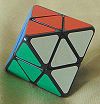
Skewb Diamond
Encyclopedia

Octahedron
In geometry, an octahedron is a polyhedron with eight faces. A regular octahedron is a Platonic solid composed of eight equilateral triangles, four of which meet at each vertex....
-shaped puzzle similar to the Rubik's Cube
Rubik's Cube
Rubik's Cube is a 3-D mechanical puzzle invented in 1974 by Hungarian sculptor and professor of architecture Ernő Rubik.Originally called the "Magic Cube", the puzzle was licensed by Rubik to be sold by Ideal Toy Corp. in 1980 and won the German Game of the Year special award for Best Puzzle that...
. It has 14 movable pieces which can be rearranged in a total of 138,240 possible combinations. This puzzle is the dual polyhedron
Dual polyhedron
In geometry, polyhedra are associated into pairs called duals, where the vertices of one correspond to the faces of the other. The dual of the dual is the original polyhedron. The dual of a polyhedron with equivalent vertices is one with equivalent faces, and of one with equivalent edges is another...
of the Skewb
Skewb
The Skewb is a combination puzzle- a mechanical puzzle in the style of Rubik's Cube—invented by Tony Durham and marketed by Uwe Mèffert. Although it is cubical in shape, it differs from Rubik's construction in that its axes of rotation pass through the corners of the cube rather than the centres of...
.
Description
The Skewb Diamond has 6 octahedral corner pieces and 8 triangular face centers. All pieces can move relative to each other. It is a deep-cut puzzle: its planes of rotationPlane of rotation
In geometry, a plane of rotation is an abstract object used to describe or visualise rotations in space. In three dimensions it is an alternative to the axis of rotation, but unlike the axis of rotation it can be used in other dimensions, such as two, four or more dimensions.Mathematically such...
bisect it.
Number of combinations
The purpose of the puzzle is to scramble its colors, and then restore it to its original solved state.The puzzle has 6 corner pieces and 8 face centers. The positions of four of the face centers is completely determined by the positions of the other 4 face centers, and only even permutations of such positions are possible, so the number of arrangements of face centers is only 4!/2. Each face center has only a single orientation.
Only even permutations of the corner pieces are possible, so the number of possible arrangements of corner pieces is 6!/2. Each corner has two possible orientations (it is not possible to change their orientation by 90° without disassembling the puzzle), but the orientation of the last corner is determined by the other 5. Hence, the number of possible corner orientations is 25.
Hence, the number of possible combinations is:

See also
- Rubik's cubeRubik's CubeRubik's Cube is a 3-D mechanical puzzle invented in 1974 by Hungarian sculptor and professor of architecture Ernő Rubik.Originally called the "Magic Cube", the puzzle was licensed by Rubik to be sold by Ideal Toy Corp. in 1980 and won the German Game of the Year special award for Best Puzzle that...
- PyraminxPyraminxThe Pyraminx is a tetrahedral puzzle similar to the Rubik's Cube. It was invented and patented by Uwe Meffert, and introduced by Tomy Toys of Japan in 1981. Meffert continues to sell it in his toy shop, ....
- MegaminxMegaminxThe Megaminx is a dodecahedron-shaped puzzle similar to the Rubik's Cube. It has a total of 50 movable pieces to rearrange, compared to the 20 movable pieces of the Rubik's cube.- History :...
- SkewbSkewbThe Skewb is a combination puzzle- a mechanical puzzle in the style of Rubik's Cube—invented by Tony Durham and marketed by Uwe Mèffert. Although it is cubical in shape, it differs from Rubik's construction in that its axes of rotation pass through the corners of the cube rather than the centres of...
- DogicDogicThe Dogic is an icosahedron-shaped puzzle like the Rubik's cube. The 5 triangles meeting at its tips may be rotated, or 5 entire faces around the tip may be rotated. It has a total of 80 movable pieces to rearrange, compared to the 20 pieces in the Rubik's cube.- History :The Dogic was patented by...
- Combination puzzlesCombination puzzlesA combination puzzle, also known as a sequential move puzzle, is a puzzle which consists of a set of pieces which can be manipulated into different combinations by a group of operations. The puzzle is solved by achieving a particular combination starting from a random combination...
- Mechanical puzzles

